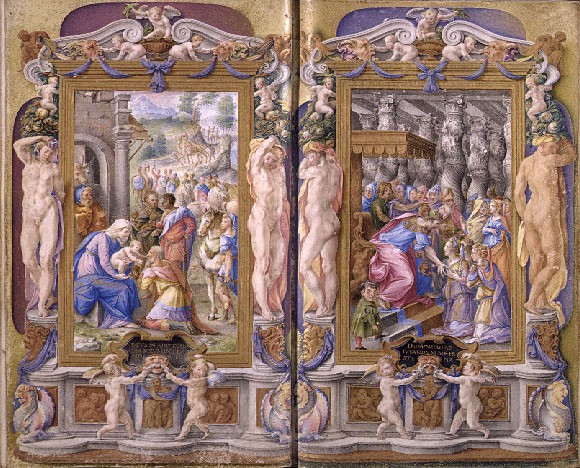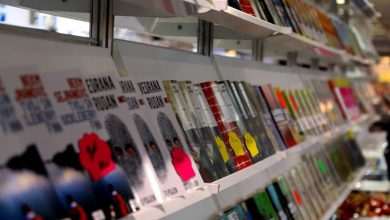Zrinjevac park, considered one of the most beautiful parks in Zagreb, is named after Nikola Subic Zrinski, a great hero and defender of Europe, but there are no monuments dedicated to him there. Instead, busts of six other great men from Croatian history watch over the south entrance to the park. They were poets, warriors, artists and diplomats who, in one way or another, have made their mark on the national history. The busts were made by Ivan Renic, an Art Nouveau artist who’s sculptures you can find all over Zagreb.
Julije Klovic (1498 – 1578)

Known in Europe as Giorgio Giulio Clovio – Croata, Klovic was the last great illuminator and miniaturist of the Renaissance era, often referred to as the Michelangelo of miniatures. His works are scattered throughout the museums of the world, most notable of which are Collona Missal kept in John Rylands University Library in Manchester (there were claims that it had to be Rafael who made the miniatures dating 1512 due to their quality, but those clams were rejected as false), Towneley Lectionary kept in the New York Public Library, and his most famous work Fernese Hours containing twenty-eight miniatures of Old and New Testament scenes, with a glorious silver gilt double-page picture representing the Corpus Christi procession in Rome, today being kept in Morgan Library, NY.
One of the most prestigious galleries in Zagreb, Klovicevi Dvori, holds his name.

Andrija Medulic (c. 1510 – 1563)

Known in Venice as Andrea Schiavone, Medulic is considered one of the most notable Italian Mannerists, and a big innovator in etching, his works later emulated by the likes of Jacques Bellagne and Rembrant. He was most known for his experiments in etching, in which he thought himself by etching drawing from Parmigianino. Due to those etches many believed that he was Parmagianino’s pupil, but those claims have never been proven. Only a few of his painting are documented, as he was mostly commissioned by private benefactors. His paintings have also influenced many of his Renaissance contemporaries.
Krsto Frankopan Ozaljski (1482 – 1527)

Krsto was a noble from the Great House of Frankopan, a warrior and Croatian viceroy who fought against the Ottomans and Venice under Maximilian I and Luis II of Hungary. He later fought and died in the civil war for the Hungarian crown, taking side with Hapsburg dynasty after Luis II did not grant him possession of Senj, a city his family owned, but was lost when king Mattias I stripped them of possessions some fifty years earlier. He claimed the ownership of the city after the convocation of Croatian nobles voted him as the viceroy of Croatian territories. Between fighting Ottomans and Venice, most of the war efforts in his life were focused on reclaiming that city, a goal he died fighting for.
Nikola Jurisic (1490 – 1545)

Nikola Jurisic was a baron and a diplomat with warrior prowess matched only by Zrinski. Due to his military successes he was appointed knighthood and was named the supreme army commander of the defending forces against the Ottomans. He also excelled as a diplomat in peace talks in Istambul. Still, his legend was formed in Koszeg, a small fort on Hungarian border. He came to defend it with 700 men against an overwhelming Ottoman force of 140 000 soldiers marching for Vienna. By the end of the siege he had only 80 men left by his side, but he withheld the position long enough for the forces in Vienna to consolidate and prevented a siege in the heart of Europe.
He spent his latter days as a secret adviser on the Vienna court.
Ivan Kukuljevic Sakcinski (1816 – 1889)

Kukuljevic was one of the leaders of the Illyrian movement. Illyirians were young Croat (and Slovenian) intellectuals who aimed to create a Croatian national establishment in Austria-Hungary through linguistic and ethnic unity, fighting against censorship and imposed Hungarian culture and language. It was the first pan-slavic movement and a part of Croatian National Revival. Kukuljevic had a successful military career but he turned to politics instead. He is best known as the first politician to address the Parliament in Croatian language, an unimaginable act at the time. Later research showed that there were earlier instances of using the native language, but not in this manner and to that effect. It was an act of patriotism not seen before and remembered still.
Ivan Mazuranic (1814 – 1890)

Out of all the men standing watch on the south entrance of Zrinjevac, Mazuranic might be the most important one for the common people in Croatia. Himself born a commoner, he was the first viceroy of Croatia that did not come from old nobility. His extensive reforms, his fight against Hungarian expansionism and Austrian rule and his ear for the plight of the people have earned him the title of folk’s ban (ban is the title of viceroy). As a politician and a lawyer he transformed Croatia from a semi feudal legal system to a modern one, implemented public education, brought secular elements into governing and transformed Croatia into a modern economy. As a linguist he coauthored the first German – Croatian dictionary that became the basis of modern Croatian language, spoke nine languages and was the last representative of classic epic poetry and Romanticism in Croatia. His most well known work is The Death of Smail-aga, an epic poem that is to this day embedded into Croatian collective consciousness as a cultural milestone.
Mazuranic is one of the Greats presented on the national currency, kuna. His is the hundred kuna bill.

